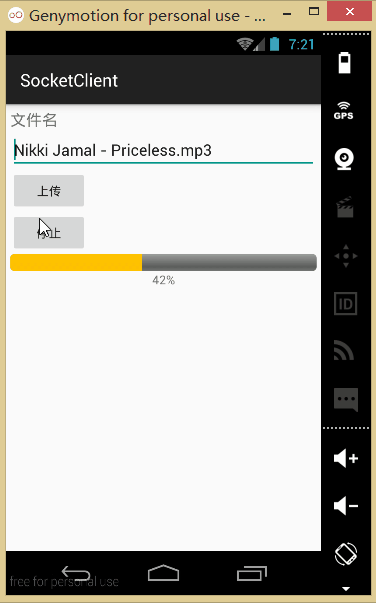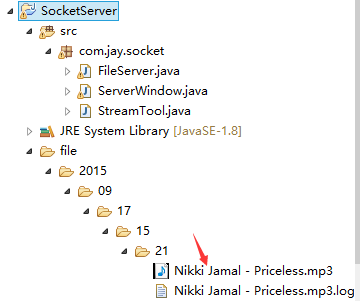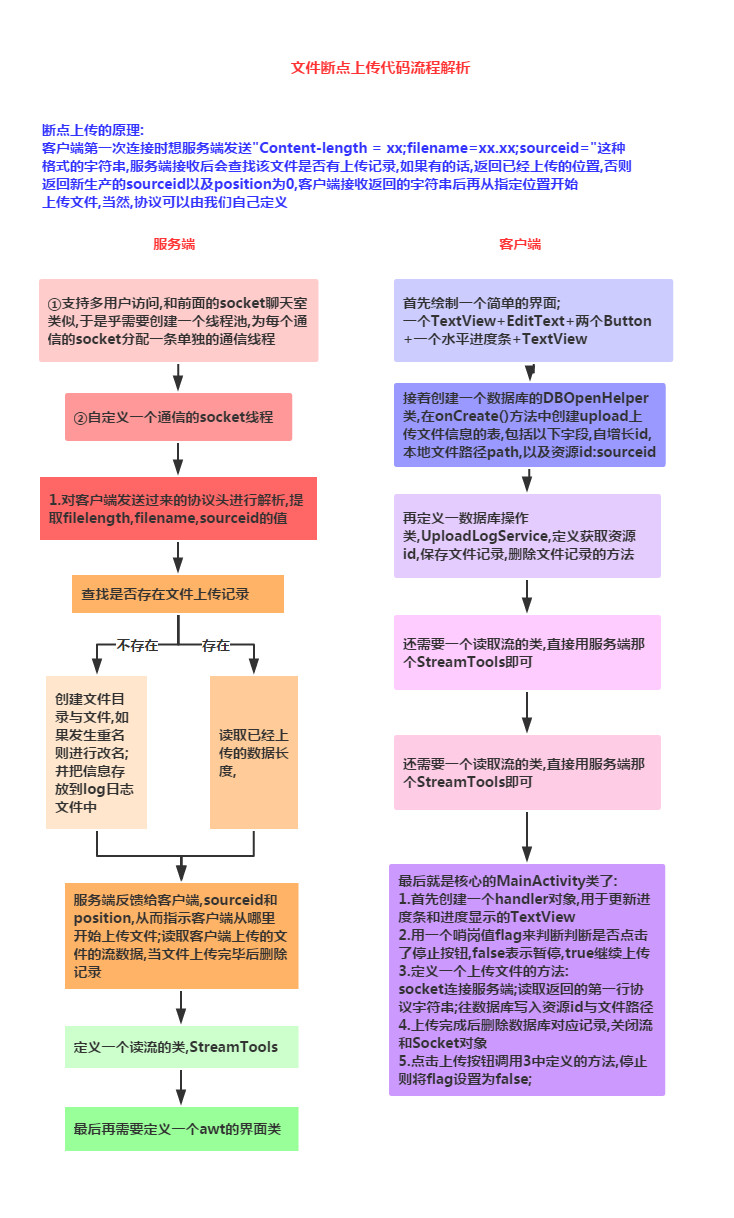In the last section, we have touched some basic concepts and usage methods of Socket. Then we have written Demo in a simple piggy chat room. I believe you have a preliminary grasp of Socket. In this section, we will learn how to use Socket to realize the intermittent transmission of large files. Here's an example of a big file uploaded by a Socket written by others. We don't need to write it by ourselves. We can use it when we need it.
1. Operation effect diagram:
1. First, we write a good Socket server to run:

2. Place an audio file in the SD card root directory:

3. Run our client:

4. After successful upload, you can see a file folder generated under the project of our server. We can find the uploaded file here:.Log is our log file.


2. Implementation flow chart:

3. Code examples:
Write a stream resolution class that both the server and the client will use:
StreamTool.java:
package com.test;
import java.io.ByteArrayOutputStream;
import java.io.File;
import java.io.FileOutputStream;
import java.io.IOException;
import java.io.InputStream;
import java.io.PushbackInputStream;
public class StreamTool {
public static void save(File file, byte[] data) throws Exception {
FileOutputStream outStream = new FileOutputStream(file);
outStream.write(data);
outStream.close();
}
public static String readLine(PushbackInputStream in) throws IOException {
char buf[] = new char[128];
int room = buf.length;
int offset = 0;
int c;
loop: while (true) {
switch (c = in.read()) {
case -1:
case '\n':
break loop;
case '\r':
int c2 = in.read();
if ((c2 != '\n') && (c2 != -1))
in.unread(c2);
break loop;
default:
if (--room < 0) {
char[] lineBuffer = buf;
buf = new char[offset + 128];
room = buf.length - offset - 1;
System.arraycopy(lineBuffer, 0, buf, 0, offset);
}
buf[offset++] = (char) c;
break;
}
}
if ((c == -1) && (offset == 0))
return null;
return String.copyValueOf(buf, 0, offset);
}
/**
* Read stream
*
* @param inStream
* @return Byte array
* @throws Exception
*/
public static byte[] readStream(InputStream inStream) throws Exception {
ByteArrayOutputStream outSteam = new ByteArrayOutputStream();
byte[] buffer = new byte[1024];
int len = -1;
while ((len = inStream.read(buffer)) != -1) {
outSteam.write(buffer, 0, len);
}
outSteam.close();
inStream.close();
return outSteam.toByteArray();
}
}1) Server implementation:
socket management and multithreading management classes:
FileServer.java:
package com.test;
import java.io.File;
import java.io.FileInputStream;
import java.io.FileOutputStream;
import java.io.IOException;
import java.io.OutputStream;
import java.io.PushbackInputStream;
import java.io.RandomAccessFile;
import java.net.ServerSocket;
import java.net.Socket;
import java.text.SimpleDateFormat;
import java.util.Date;
import java.util.HashMap;
import java.util.Map;
import java.util.Properties;
import java.util.concurrent.ExecutorService;
import java.util.concurrent.Executors;
public class FileServer {
private ExecutorService executorService;// Thread pool
private int port;// Listening port
private boolean quit = false;// Sign out
private ServerSocket server;
private Map<Long, FileLog> datas = new HashMap<Long, FileLog>();// Store breakpoint data
public FileServer(int port) {
this.port = port;
// Create a thread pool with (cpu number * 50) threads
executorService = Executors.newFixedThreadPool(Runtime.getRuntime().availableProcessors() * 50);
}
/**
* Sign out
*/
public void quit() {
this.quit = true;
try {
server.close();
} catch (IOException e) {
}
}
/**
* Start up service
*
* @throws Exception
*/
public void start() throws Exception {
server = new ServerSocket(port);
while (!quit) {
try {
Socket socket = server.accept();
// To support multi-user concurrent access, thread pool is used to manage the connection requests of each user.
executorService.execute(new SocketTask(socket));
} catch (Exception e) {
// e.printStackTrace();
}
}
}
private final class SocketTask implements Runnable {
private Socket socket = null;
public SocketTask(Socket socket) {
this.socket = socket;
}
public void run() {
try {
System.out.println("accepted connection " + socket.getInetAddress() + ":" + socket.getPort());
PushbackInputStream inStream = new PushbackInputStream(socket.getInputStream());
// Get the first line of protocol data from the client: Content-Length = 143253434; filename = xxxx.3gp; sourceid=
// If the user uploads the file for the first time, the value of sourceid is empty.
String head = StreamTool.readLine(inStream);
System.out.println(head);
if (head != null) {
// The following parameters are extracted from the protocol data
String[] items = head.split(";");
String filelength = items[0].substring(items[0].indexOf("=") + 1);
String filename = items[1].substring(items[1].indexOf("=") + 1);
String sourceid = items[2].substring(items[2].indexOf("=") + 1);
long id = System.currentTimeMillis();// Production resource id, if uniqueness is required, UUID can be used
FileLog log = null;
if (sourceid != null && !"".equals(sourceid)) {
id = Long.valueOf(sourceid);
log = find(id);// Find if the uploaded file has an upload record
}
File file = null;
int position = 0;
if (log == null) {// If no upload record exists, add a trace record to the file
String path = new SimpleDateFormat("yyyy/MM/dd/HH/mm").format(new Date());
File dir = new File("file/" + path);
if (!dir.exists())
dir.mkdirs();
file = new File(dir, filename);
if (file.exists()) {// If the uploaded file is renamed, it is renamed
filename = filename.substring(0, filename.indexOf(".") - 1) + dir.listFiles().length
+ filename.substring(filename.indexOf("."));
file = new File(dir, filename);
}
save(id, file);
} else {// If there is an upload record, read the length of the uploaded data
file = new File(log.getPath());// The path to get the file from the upload record
if (file.exists()) {
File logFile = new File(file.getParentFile(), file.getName() + ".log");
if (logFile.exists()) {
Properties properties = new Properties();
properties.load(new FileInputStream(logFile));
position = Integer.valueOf(properties.getProperty("length"));// Read the length of uploaded data
}
}
}
OutputStream outStream = socket.getOutputStream();
String response = "sourceid=" + id + ";position=" + position + "\r\n";
// When the server receives the request information from the client, it returns the response information to the client: sourceid=1274773833264;position=0.
// Sorceid is generated by the server and uniquely identifies the uploaded file. position indicates where the client starts uploading the file.
outStream.write(response.getBytes());
RandomAccessFile fileOutStream = new RandomAccessFile(file, "rwd");
if (position == 0)
fileOutStream.setLength(Integer.valueOf(filelength));// Set file length
fileOutStream.seek(position);// Specifies to start writing data from a specific location of the file
byte[] buffer = new byte[1024];
int len = -1;
int length = position;
while ((len = inStream.read(buffer)) != -1) {// Read and write data from input stream to file
fileOutStream.write(buffer, 0, len);
length += len;
Properties properties = new Properties();
properties.put("length", String.valueOf(length));
FileOutputStream logFile = new FileOutputStream(
new File(file.getParentFile(), file.getName() + ".log"));
properties.store(logFile, null);// Real-time recording of received file length
logFile.close();
}
if (length == fileOutStream.length())
delete(id);
fileOutStream.close();
inStream.close();
outStream.close();
file = null;
}
} catch (Exception e) {
e.printStackTrace();
} finally {
try {
if (socket != null && !socket.isClosed())
socket.close();
} catch (IOException e) {
}
}
}
}
public FileLog find(Long sourceid) {
return datas.get(sourceid);
}
// Save upload records
public void save(Long id, File saveFile) {
// It can be stored in a database in the future.
datas.put(id, new FileLog(id, saveFile.getAbsolutePath()));
}
// When the file is uploaded, delete the record
public void delete(long sourceid) {
if (datas.containsKey(sourceid))
datas.remove(sourceid);
}
private class FileLog {
private Long id;
private String path;
public Long getId() {
return id;
}
public void setId(Long id) {
this.id = id;
}
public String getPath() {
return path;
}
public void setPath(String path) {
this.path = path;
}
public FileLog(Long id, String path) {
this.id = id;
this.path = path;
}
}
}Server-side interface class: ServerWindow.java:
public class ServerWindow extends Frame {
private FileServer s = new FileServer(12345);
private Label label;
public ServerWindow(String title) {
super(title);
label = new Label();
add(label, BorderLayout.PAGE_START);
label.setText("The server has been started");
this.addWindowListener(new WindowListener() {
public void windowOpened(WindowEvent e) {
new Thread(new Runnable() {
public void run() {
try {
s.start();
} catch (Exception e) {
// e.printStackTrace();
}
}
}).start();
}
public void windowIconified(WindowEvent e) {
}
public void windowDeiconified(WindowEvent e) {
}
public void windowDeactivated(WindowEvent e) {
}
public void windowClosing(WindowEvent e) {
s.quit();
System.exit(0);
}
public void windowClosed(WindowEvent e) {
}
public void windowActivated(WindowEvent e) {
}
});
}
/**
* @param args
*/
public static void main(String[] args) throws IOException {
InetAddress address = InetAddress.getLocalHost();
ServerWindow window = new ServerWindow("File upload server:" + address.getHostAddress());
window.setSize(400, 300);
window.setVisible(true);
}
}2) Client (Android)
First, the layout file: activity_main.xml:
<?xml version="1.0" encoding="utf-8"?>
<LinearLayout xmlns:android="http://schemas.android.com/apk/res/android"
android:layout_width="fill_parent"
android:layout_height="fill_parent"
android:orientation="vertical"
android:padding="5dp">
<TextView
android:layout_width="fill_parent"
android:layout_height="wrap_content"
android:text="file name"
android:textSize="18sp" />
<EditText
android:id="@+id/edit_fname"
android:layout_width="fill_parent"
android:layout_height="wrap_content"
android:text="Nikki Jamal - Priceless.mp3" />
<Button
android:id="@+id/btn_upload"
android:layout_width="wrap_content"
android:layout_height="wrap_content"
android:text="upload" />
<Button
android:id="@+id/btn_stop"
android:layout_width="wrap_content"
android:layout_height="wrap_content"
android:text="Stop it" />
<ProgressBar
android:id="@+id/pgbar"
style="@android:style/Widget.ProgressBar.Horizontal"
android:layout_width="fill_parent"
android:layout_height="40px" />
<TextView
android:id="@+id/txt_result"
android:layout_width="fill_parent"
android:layout_height="wrap_content"
android:gravity="center" />
</LinearLayout> Because of the breakpoint continuation, we need to save the upload progress, we need to use the database, here we define a database management class: DBOpenHelper.java:
public class DBOpenHelper extends SQLiteOpenHelper {
public DBOpenHelper(Context context) {
super(context, "jay.db", null, 1);
}
@Override
public void onCreate(SQLiteDatabase db) {
db.execSQL("CREATE TABLE IF NOT EXISTS uploadlog (_id integer primary key autoincrement, path varchar(20), sourceid varchar(20))");
}
@Override
public void onUpgrade(SQLiteDatabase db, int oldVersion, int newVersion) {
}
}public class UploadHelper {
private DBOpenHelper dbOpenHelper;
public UploadHelper(Context context) {
dbOpenHelper = new DBOpenHelper(context);
}
public String getBindId(File file) {
SQLiteDatabase db = dbOpenHelper.getReadableDatabase();
Cursor cursor = db.rawQuery("select sourceid from uploadlog where path=?",
new String[] { file.getAbsolutePath() });
if (cursor.moveToFirst()) {
return cursor.getString(0);
}
return null;
}
public void save(String sourceid, File file) {
SQLiteDatabase db = dbOpenHelper.getWritableDatabase();
db.execSQL("insert into uploadlog(path,sourceid) values(?,?)",
new Object[] { file.getAbsolutePath(), sourceid });
}
public void delete(File file) {
SQLiteDatabase db = dbOpenHelper.getWritableDatabase();
db.execSQL("delete from uploadlog where path=?", new Object[] { file.getAbsolutePath() });
}
}By the way, don't forget that the client will also paste the stream resolution class, and finally our MainActivity.java:
public class MainActivity extends AppCompatActivity implements View.OnClickListener {
private EditText edit_fname;
private Button btn_upload;
private Button btn_stop;
private ProgressBar pgbar;
private TextView txt_result;
private UploadHelper upHelper;
private boolean flag = true;
private Handler handler = new Handler() {
@Override
public void handleMessage(Message msg) {
pgbar.setProgress(msg.getData().getInt("length"));
float num = (float) pgbar.getProgress() / (float) pgbar.getMax();
int result = (int) (num * 100);
txt_result.setText(result + "%");
if (pgbar.getProgress() == pgbar.getMax()) {
Toast.makeText(MainActivity.this, "Upload Success", Toast.LENGTH_SHORT).show();
}
}
};
@Override
public void onCreate(Bundle savedInstanceState) {
super.onCreate(savedInstanceState);
setContentView(R.layout.activity_main);
bindViews();
upHelper = new UploadHelper(this);
}
private void bindViews() {
edit_fname = (EditText) findViewById(R.id.edit_fname);
btn_upload = (Button) findViewById(R.id.btn_upload);
btn_stop = (Button) findViewById(R.id.btn_stop);
pgbar = (ProgressBar) findViewById(R.id.pgbar);
txt_result = (TextView) findViewById(R.id.txt_result);
btn_upload.setOnClickListener(this);
btn_stop.setOnClickListener(this);
}
@Override
public void onClick(View v) {
switch (v.getId()) {
case R.id.btn_upload:
String filename = edit_fname.getText().toString();
flag = true;
if (Environment.getExternalStorageState().equals(Environment.MEDIA_MOUNTED)) {
File file = new File(Environment.getExternalStorageDirectory(), filename);
if (file.exists()) {
pgbar.setMax((int) file.length());
uploadFile(file);
} else {
Toast.makeText(MainActivity.this, "Documents do not exist~", Toast.LENGTH_SHORT).show();
}
} else {
Toast.makeText(MainActivity.this, "SD Card does not exist or is unavailable", Toast.LENGTH_SHORT).show();
}
break;
case R.id.btn_stop:
flag = false;
break;
}
}
private void uploadFile(final File file) {
new Thread(new Runnable() {
public void run() {
try {
String sourceid = upHelper.getBindId(file);
Socket socket = new Socket("172.16.2.54", 12345);
OutputStream outStream = socket.getOutputStream();
String head = "Content-Length=" + file.length() + ";filename=" + file.getName()
+ ";sourceid=" + (sourceid != null ? sourceid : "") + "\r\n";
outStream.write(head.getBytes());
PushbackInputStream inStream = new PushbackInputStream(socket.getInputStream());
String response = StreamTool.readLine(inStream);
String[] items = response.split(";");
String responseSourceid = items[0].substring(items[0].indexOf("=") + 1);
String position = items[1].substring(items[1].indexOf("=") + 1);
if (sourceid == null) {//If the file is uploaded for the first time, the resource id bound by the file does not exist in the database.
upHelper.save(responseSourceid, file);
}
RandomAccessFile fileOutStream = new RandomAccessFile(file, "r");
fileOutStream.seek(Integer.valueOf(position));
byte[] buffer = new byte[1024];
int len = -1;
int length = Integer.valueOf(position);
while (flag && (len = fileOutStream.read(buffer)) != -1) {
outStream.write(buffer, 0, len);
length += len;//Accumulate the length of uploaded data
Message msg = new Message();
msg.getData().putInt("length", length);
handler.sendMessage(msg);
}
if (length == file.length()) upHelper.delete(file);
fileOutStream.close();
outStream.close();
inStream.close();
socket.close();
} catch (Exception e) {
Toast.makeText(MainActivity.this, "Upload anomaly~", Toast.LENGTH_SHORT).show();
}
}
}).start();
}
}Finally, remember to write these permissions to ** Android Manifest. XML **!
<! - Create and delete file permissions in SDCD --> ___________. <uses-permission android:name="android.permission.MOUNT_UNMOUNT_FILESYSTEMS"/> <! - Write data permissions to SDCard - > <uses-permission android:name="android.permission.WRITE_EXTERNAL_STORAGE"/> <! - Access to the internet - > <uses-permission android:name="android.permission.INTERNET"/>